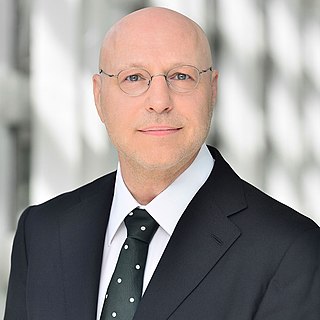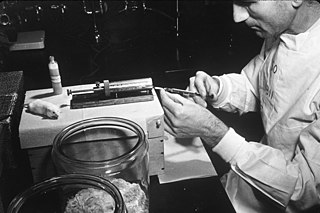Related Research Articles

Gene therapy is a medical technology that aims to produce a therapeutic effect through the manipulation of gene expression or through altering the biological properties of living cells.

Transplant rejection occurs when transplanted tissue is rejected by the recipient's immune system, which destroys the transplanted tissue. Transplant rejection can be lessened by determining the molecular similitude between donor and recipient and by use of immunosuppressant drugs after transplant.

Adeno-associated viruses (AAV) are small viruses that infect humans and some other primate species. They belong to the genus Dependoparvovirus, which in turn belongs to the family Parvoviridae. They are small replication-defective, nonenveloped viruses and have linear single-stranded DNA (ssDNA) genome of approximately 4.8 kilobases (kb).

Viral vectors are tools commonly used by molecular biologists to deliver genetic material into cells. This process can be performed inside a living organism or in cell culture. Viruses have evolved specialized molecular mechanisms to efficiently transport their genomes inside the cells they infect. Delivery of genes or other genetic material by a vector is termed transduction and the infected cells are described as transduced. Molecular biologists first harnessed this machinery in the 1970s. Paul Berg used a modified SV40 virus containing DNA from the bacteriophage λ to infect monkey kidney cell maintained in culture.

Bare lymphocyte syndrome type II is a rare recessive genetic condition in which a group of genes called major histocompatibility complex class II are not expressed. The result is that the immune system is severely compromised and cannot effectively fight infection.
A nonsense suppressor is a factor which can inhibit the effect of the nonsense mutation. Nonsense suppressors can be generally divided into two classes: a) a mutated tRNA which can bind with a termination codon on mRNA; b) a mutation on ribosomes decreasing the effect of a termination codon. It is believed that nonsense suppressors keep a low concentration in the cell and do not disrupt normal translation most of the time. In addition, many genes do not have only one termination codon, and cells commonly use ochre codons as the termination signal, whose nonsense suppressors are usually inefficient.

Allograft inflammatory factor 1 (AIF-1) also known as ionized calcium-binding adapter molecule 1 (IBA1) is a protein that in humans is encoded by the AIF1 gene.
Current Gene Therapy is a peer-reviewed medical journal published by Bentham Science Publishers. The editor-in-chief is Liang Cheng. The focus of this journal is pre-clinical or clinical research on gene therapy. Formats of publication include original research reports, review papers, and rapid communications ("letters").
Gene therapy for osteoarthritis is the application of gene therapy to treat osteoarthritis (OA). Unlike pharmacological treatments which are administered locally or systemically as a series of interventions, gene therapy aims to establish sustained therapeutic effect after a single, local injection.
Self-complementary adeno-associated virus (scAAV) is a viral vector engineered from the naturally occurring adeno-associated virus (AAV) to be used as a tool for gene therapy. Use of recombinant AAV (rAAV) has been successful in clinical trials addressing a variety of diseases. This lab-made progeny of rAAV is termed "self-complementary" because the coding region has been designed to form an intra-molecular double-stranded DNA template. A rate-limiting step for the standard AAV genome involves the second-strand synthesis since the typical AAV genome is a single-stranded DNA template. However, this is not the case for scAAV genomes. Upon infection, rather than waiting for cell mediated synthesis of the second strand, the two complementary halves of scAAV will associate to form one double stranded DNA (dsDNA) unit that is ready for immediate replication and transcription. The caveat of this construct is that instead of the full coding capacity found in rAAV (4.7–6kb) scAAV can only hold about half of that amount (≈2.4kb).
Adenovirus varieties have been explored extensively as a viral vector for gene therapy and also as an oncolytic virus.

Lentiviral vectors in gene therapy is a method by which genes can be inserted, modified, or deleted in organisms using lentiviruses.
DNA-directed RNA interference (ddRNAi) is a gene-silencing technique that utilizes DNA constructs to activate an animal cell's endogenous RNA interference (RNAi) pathways. DNA constructs are designed to express self-complementary double-stranded RNAs, typically short-hairpin RNAs, that bring about the silencing of a target gene or genes once processed. Any RNA, including endogenous messenger RNA (mRNAs) or viral RNAs, can be silenced by designing constructs to express double-stranded RNA complementary to the desired mRNA target.

Shaf Keshavjee is a Canadian surgeon and the current Surgeon-in-Chief at University Health Network in Toronto, the Director of the Toronto Lung Transplant Program, as well as a clinical scientist and professor with the University of Toronto.
Isolated organ perfusion technique is employed to precipitate an organ's perfusion and circulation that are independent/isolated from the body's systemic circulation for various purposes such as organ-localized chemotherapy, organ-targeted delivery of drug, gene or anything else, organ transplantation, and organ injury recovery. The technique has been widely studied in animal and human for decades. Before the implementation, the perfusion system will be selected and the process can be similar to organ bath. Isolated organ perfusion technique, nevertheless, is averagely conducted in vivo without leaving the organ alone as a whole out of the body.

Rainer Blasczyk is a German physician, university professor, entrepreneur and philanthropist. He specializes in transfusion medicine with a focus on transplantation and immunogenetics. He is considered a pioneer in genetic engineering of allografts to increase histocompatibility and prevent organ rejection after organ transplantation.
Jean Bennett is the F. M. Kirby Professor of Ophthalmology in the Perelman School of Medicine at the University of Pennsylvania. Her research focuses on gene therapy for retinal diseases. Her laboratory developed the first FDA approved gene therapy for use in humans, which treats a rare form of blindness. She was elected a member of the National Academy of Sciences in 2022.

A viral vector vaccine is a vaccine that uses a viral vector to deliver genetic material (DNA) that can be transcribed by the recipient's host cells as mRNA coding for a desired protein, or antigen, to elicit an immune response. As of April 2021, six viral vector vaccines, four COVID-19 vaccines and two Ebola vaccines, have been authorized for use in humans.

Cellular adoptive immunotherapy is a type of immunotherapy. Immune cells such as T-cells are usually isolated from patients for expansion or engineering purposes and reinfused back into patients to fight diseases using their own immune system. A major application of cellular adoptive therapy is cancer treatment, as the immune system plays a vital role in the development and growth of cancer. The primary types of cellular adoptive immunotherapies are T cell therapies. Other therapies include CAR-T therapy, CAR-NK therapy, macrophage-based immunotherapy and dendritic cell therapy.

Hydrodynamic Delivery (HD) is a method of DNA insertion in rodent models. Genes are delivered via injection into the bloodstream of the animal, and are expressed in the liver. This protocol is helpful to determine gene function, regulate gene expression, and develop pharmaceuticals in vivo.
References
- ↑ Cypel, Marcelo; Liu, Mingyao; Rubacha, Matt; Yeung, Jonathan C.; Hirayama, Shin; Anraku, Masaki; Sato, Masaaki; Medin, Jeffrey; Davidson, Beverly L.; Perrot, Marc de; Waddell, Thomas K. (2009-10-28). "Functional Repair of Human Donor Lungs by IL-10 Gene Therapy". Science Translational Medicine. 1 (4): 4ra9. doi:10.1126/scitranslmed.3000266. ISSN 1946-6234. PMID 20368171. S2CID 13366956.
- ↑ Machuca, Tiago N.; Cypel, Marcelo; Bonato, Riccardo; Yeung, Jonathan C.; Chun, Yi-Min; Juvet, Stephen; Guan, Zehong; Hwang, David M.; Chen, Manyin; Saito, Tomohito; Harmantas, Constantine (2017-09-01). "Safety and Efficacy of Ex Vivo Donor Lung Adenoviral IL-10 Gene Therapy in a Large Animal Lung Transplant Survival Model". Human Gene Therapy. 28 (9): 757–765. doi:10.1089/hum.2016.070. ISSN 1043-0342. PMID 28052693.
- ↑ Figueiredo, Constanca; Carvalho Oliveira, Marco; Chen-Wacker, Chen; Jansson, Katharina; Höffler, Klaus; Yuzefovych, Yuliia; Pogozhykh, Olena; Jin, Zhu; Kühnel, Mark; Jonigk, Danny; Wiegmann, Bettina (2019-04-04). "Immunoengineering of the Vascular Endothelium to Silence MHC Expression During Normothermic Ex Vivo Lung Perfusion". Human Gene Therapy. 30 (4): 485–496. doi:10.1089/hum.2018.117. ISSN 1043-0342. PMID 30261752.
- ↑ Yuzefovych, Yuliia; Valdivia, Emilio; Rong, Song; Hack, Franziska; Rother, Tamina; Schmitz, Jessica; Bräsen, Jan Hinrich; Wedekind, Dirk; Moers, Cyril; Wenzel, Nadine; Gueler, Faikah (2020). "Genetic Engineering of the Kidney to Permanently Silence MHC Transcripts During ex vivo Organ Perfusion". Frontiers in Immunology. 11: 265. doi: 10.3389/fimmu.2020.00265 . ISSN 1664-3224. PMC 7042208 . PMID 32140158.